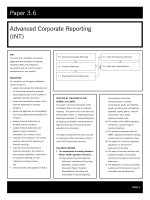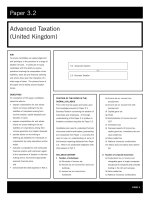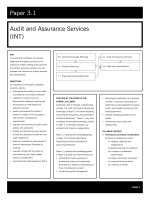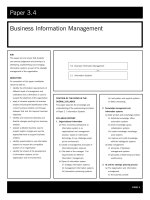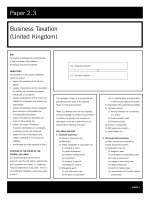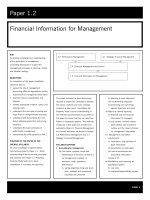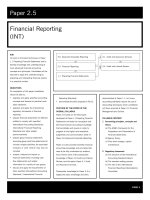acca test book Strategic Financial Management pptx
Bạn đang xem bản rút gọn của tài liệu. Xem và tải ngay bản đầy đủ của tài liệu tại đây (362.28 KB, 11 trang )
PAGE 3
Paper 3.7
Strategic Financial Management
3.3 Performance Management
3.7 Strategic Financial Management
2.4 Financial Management and Control
1.2 Financial Information for Management
AIM
To ensure that candidates can exercise
judgement and technique to make
commercial value added decisions in
strategic financial management and are
able to adapt to factors affecting those
decisions.
OBJECTIVES
On completion of this paper candidates
should be able to:
• prepare reports for management
explaining and evaluating the financial
consequences of strategic decisions
• identify and evaluate appropriate
sources of finance, their risks and costs
• assess potential investment decisions
and strategies
• understand the impact of the global
business environment on national and
multinational organisations
• explain, demonstrate and recommend
suitable risk management techniques
• understand the significance of cash
management and the treasury function
in the commercial environment
• select the techniques most appropriate
to optimise the employment of financial
resources and critically evaluate such
techniques
• analyse and evaluate financial
information relating to past and future
business performance
• demonstrate the skills expected in Part 3.
POSITION OF THE PAPER IN THE
OVERALL SYLLABUS
Candidates will require a thorough
understanding of the financial management
section of Paper 2.4 Financial Management
and Control. Candidates will also be
required to apply quantitative techniques
covered in earlier papers.
Paper 3.7 develops the financial
management elements of Paper 2.4 by:
• providing a more critical analysis of
corporate governance
• examining the strategic implications of
short-term and long-term financial
planning
• in-depth analysis of risk management in
both domestic and international contexts
• more rigorous analysis of investment
decisions and the cost of capital,
including CAPM and other models
• analysis of corporate growth and
restructuring through mergers,
acquisitions and other means
• introducing international dimensions of
the treasury function
• considering the global economic
environment and other influences on
financial management decisions
• analysis of global financial management
decisions
• introducing ethical considerations.
Paper 3.7 will draw upon strategic
management and business planning issues
covered in Paper 3.5 Strategic Business
Planning and Development in the context of
financial planning.
Paper 3.7 covers mergers, acquisitions and
corporate restructuring from a financial
perspective, areas covered from an
accounting perspective in Paper 3.6
Advanced Corporate Reporting.
PAGE 4
Paper 3.7: Strategic Financial Management (Continued)
Strategic Financial Management (Continued)
SYLLABUS CONTENT
1 Objectives and corporate governance
(a) The aims and objectives of an
organisation and their impact on
business planning.
(b) Key stakeholders of an organisation:
shareholders, lenders, directors,
employees, customers, suppliers and
the government.
(c) Environmental issues and their
impact on corporate objectives and
governance.
(d) The concept of goal congruence and
how it might be achieved.
(e) Key aspects of governance in the UK
and internationally.
(f) The implications of corporate
governance for organisations.
2 Strategy formulation
(a) The strategic planning process and
its link with investment decisions
(i) the development and analysis of
financial plans to meet agreed
objectives
(ii) seeking, clarifying and confirming
information (e.g. on the current
or past business position through
ratios or other forms of analysis)
relevant to the achievement of
business objectives
(iii) advising clients on the strategies
that a company might use to
expand or maintain its current
market position, and on exit
strategies
(iv)long term financial planning
including measures of value,
profit, optimisation and utility
(v) the use of free cash flow in
financial planning
(vi)techniques for valuing individual
shares and other securities and
for valuing a business, including
EVA and SVA.
(b) Strategic planning for multinationals
(i) entry and exit barriers
(ii) competitive advantage.
3 Risk analysis
(a) Cost of capital
(i) the cost of equity (CAPM and
dividend growth model)
(ii) the cost of debt
(iii) the weighted average cost of
capital (WACC)
(iv) the impact of varying capital
structures on the cost of capital.
(b) Interest rate and foreign exchange risk
(i) the identification of interest rate
and foreign exchange exposure
(ii) yield curves and their significance
to financial managers
(iii) hedging risk using forwards,
futures, options, swaps, FRAs
and other products
(iv) the scope and benefit of
financial engineering.
4 Investment decisions
(a) Decision making techniques
(i) detailed knowledge of discounted
cash flow(NPV)
(ii) adjusted NPV (APV)
(iii) portfolio theory and CAPM and
their value to managers
(iv) options embedded in
investments (basic knowledge
only).
(b) Expansion strategies
(i) organic growth, mergers and
acquisitions
(ii) valuations for mergers and
acquisitions
(iii) takeover and defence strategies
(iv) planning for post-merger success
and audit.
(c) Corporate reorganisation
(i) divestments
(ii) buy-outs and buy-ins
(iii) corporate restructuring
(iv) going private
(v) share repurchases.
5 Treasury management and financial
forecasting
(a) Methods of financing short and long
term investment, including mergers
and acquisitions.
(b) The role of cash flow forecasting in
business planning
(i) development and analysis of
short-term financial plans.
(c) Role of treasury function
(i) activities of treasury managers
(ii) centralised versus decentralised
treasury functions.
(d) Dividend policy
(i) influences on dividend policy
PAGE 5
Strategic Financial Management (Continued)
(ii) the effect of dividends on
company value.
6 The global economic environment
(a) International factors affecting
business developments
(i) trends in global competition
(ii) the role of multinational
companies in the world economy
(iii) free trade, protectionism, trade
agreements, common markets
(iv) role of World Bank and
International Monetary
Fund(IMF) and other
international organisations
(v) economic relations between
developed and developing
countries including problems of
debt and development
(vi)introduction of a single currency.
(b) Exchange rate determination
(i) influences on exchange rates
(ii) models of exchange rate
determination
(iii) different forms of exchange rate
system.
7 Global financial management
(a) Appraisal of overseas investment
decisions
(i) alternative forms of foreign
investment
(ii) the impact of overseas taxation
(basic principles only)
(iii) overseas cost of capital and
capital structure
(iv)forecasting future exchange rates
(v) political risk.
(b) Raising capital overseas
(i) international capital markets
including the Euromarkets
(ii) overseas domestic capital markets
(iii) international banking.
(c) Managing financial resources within
a multinational group
(i) financial control within a group
of companies
(ii) international cash management
(iii) international transfer pricing
(iv) performance measurement and
evaluation.
(d) Management of international trade
(i) the management of the risks of
international trade
(ii) the finance of international trade.
8 Ethical considerations
(a) Ethics and business conduct, including
international ethical considerations.
EXCLUDED TOPICS
The syllabus content outlines the areas for
assessment. No areas of knowledge are
specifically excluded from the syllabus.
KEY AREAS OF THE SYLLABUS
The key topic areas are as follows:
• investment decisions
• risk analysis
• global financial management
• treasury management
• financial forecasting.
APPROACH TO EXAMINING THE
SYLLABUS
The examination is a three hour paper
comprising a mix of computational and
discursive elements. The core questions
will normally be in the form of a case study
or case scenario.
Key areas of the syllabus will always be
tested in the compulsory questions, and
may be tested in the elective questions.
Number
of marks
Section A: 2 compulsory questions 70
Section B: Choice of 2 from 4
questions (15 marks each) 30
100
ADDITIONAL INFORMATION
The Study Guide provides more detailed
guidance on the syllabus.
RELEVANT TEXTS
There are a number of sources from which
you can obtain a series of materials written
for the ACCA examinations. These are
listed below:
Foulks Lynch – ACCA's official publisher
Contact number: +44 (0)20 8831 9990.
Website: www.foulkslynch.com
Accountancy Tuition Centre (ATC)
International
Contact number: +44 (0)141 880 6469.
Website: www.ptc-global.com
PAGE 6
Strategic Financial Management (Continued)
BPP
Contact number: +44 (0)20 8740 2211.
Website: www.bpp.com
The Financial Training Company
Contact number: +44 (0)174 785 4302.
Website: www.financial-training.com
Candidates may also find the following
general texts useful:
R H Pike, C W Neale Corporate Finance
and Investment Prentice Hall
ISBN 0130812706
Mark Grinblatt and S.Titman
Financial Markets and Corporate Strategy
McGraw Hill ISBN 0071157611
For international aspects of the syllabus:
I Demirag, S Goddard Financial
Management for International Business
McGraw Hill ISBN 0077078691
Students wishing to broaden their
understanding of Paper 3.7 are
recommended to consider:
J Stern, D Chew (eds) The Revolution in
Corporate Finance Blackwell
ISBN 0631185542.
Wider reading is also desirable, especially
regular study of relevant articles in ACCA's
student accountant.
STUDY SESSIONS
1 & 2 Objectives and Corporate
Governance
(a) Objectives of organisations
(i) identify the possible aims and
objectives of organisations, both
profit seeking and non-profit
seeking.
(ii) discuss the impact of alternative
objectives for business planning.
(iii) identify key stakeholders of
organisations including
shareholders, lenders, directors,
employees, customers, suppliers
and the government and the
importance of each group of
stakeholders to organisations.
(iv)be aware of different
environmental issues that may
influence corporate objectives
and governance.
(b) Conflicts of interest and their
resolution
(i) describe the goals of different
interest groups.
(ii) identify directors’ powers and
behaviour, including the
significance of creative
accounting, off-balance sheet
finance and the influence of the
threat of take-over.
(iii) understand the principles of
agency theory and their
contribution to the debate on
governance.
(iv) understand the potential for
conflict between owners,
directors, managers and other
interest groups.
(v) discuss the meaning of goal
congruence, and understand how
it might be achieved through the
use of alternative reward systems
including share option schemes
and profit related pay.
(c) Corporate Governance
(i) understand the significance of
changing share ownership
patterns for the company.
(ii) define the meaning of corporate
governance from an UK
perspective and briefly contrast
between UK practices and those
of other countries especially the
USA, Continental Europe and the
Far East.
(iii) understand the debate regarding
corporate governance, including
developments from the Cadbury,
Greenbury and Hampel reports.
(d) The implications of corporate
governance for organisations
(i) identify the role of auditors, audit
committees, remuneration
committees, non-executive
directors etc. in corporate
governance.
(ii) discuss the role of non-executive
directors, administrators etc. with
respect to the organisation.
PAGE 7
Strategic Financial Management (Continued)
(iii) discuss the possible effects of
corporate governance on
corporate financial strategy.
3 & 4 Strategies
(a) Strategy formulation
(i) understand how business plans
are developed and analysed to
meet specified objectives.
(ii) analyse past, current and
expected future performance of
the organisation through ratios
and other techniques to provide
relevant information for business
planning.
(iii) compare actual and expected
performance, highlighting areas
for further investigation.
(iv) understand the relationship
between short-term and long-
term financial planning, and the
potential conflict between short-
term and long-term
objectives.
(b) Expansion and market maintenance
strategies
(i) describe alternative strategies for
long-term growth, organic growth
versus external growth, and the key
dimensions of strategy that need
to be addressed if a business is
considering organic growth and/or
the maintenance of market share.
(ii) describe top down versus bottom
up planning systems.
(iii) understand the use of budgets to
influence the success of financial
planning.
(iv) discuss the relationship of
investment decisions to long-term
planning.
(v) review the nature of financial
control. The three levels of
control: strategic, tactical and
operational.
5 & 6 The valuation of securities
(a) Understand models for the valuation
of shares, including dividend growth
models, earnings growth models,
Shareholder Value Added (SVA),
Economic Value Added (EVA), and
Market Value Added (MVA) and use
such models to estimate value from
given information.
(b) Be aware of the theoretical and
practical limitations of such models.
(c) Discuss the relevance of accounting
(d) Information to share valuation.
(e) Be aware of practical influences on
share price, including reasons why
share prices differ from their
theoretical values, including the
evidence for market efficiency.
(f) Understand and apply models for the
valuation of debt and other
securities.
(g) Understand the meaning of free cash
flow and estimate the relevant free
cash flow for use in financial
planning and valuing companies.
7 & 8 Investment decisions
(a) Net present value
(i) revise NPV analysis, including
the identification of relevant cash
flows, and the impact of price
level changes and taxation.
(ii) understand the significance of
market efficiency to financial
decision-making based upon
NPV.
(b) Portfolio theory
(i) understand the benefits of
portfolio diversification.
(ii) estimate the risk and return of
portfolios.
(iii) understand the meaning of mean-
variance efficiency for two asset
portfolios and portfolios of
many assets, efficient portfolios
and the efficient frontier.
(iv) understand the concept of utility
and its importance to portfolio
selection.
(v) explain portfolio selection when
both risky and risk free assets are
available.
(vi) discuss the nature and
significance of the Capital Market
Line.
(vii) discuss the relevance of
portfolio theory to practical
financial management.
(viii) discuss the limitations of portfolio
theory.
PAGE 8
Strategic Financial Management (Continued)
9 The Capital Asset Pricing Model
(a) Understand the meaning and
significance of systematic and
unsystematic risk.
(b) Discuss the Security Market Line.
(c) Understand what is meant by alpha
and beta factors, their interpretation
and how they are calculated.
(d) Discuss the problems of using
historic data as the basis for future
decision-making, and evidence of
the stability of beta over time.
(e) Describe the assumptions of CAPM.
(f) Understand the uses of the model in
financial management.
(g) Discuss the limitations of the model,
including some of the instances
when it does not perform as
expected, (e.g. low beta investments,
low PE investments, day of week
effects etc.)
10 The cost of capital
(a) Estimate the cost of equity, using the
CAPM and dividend valuation models.
(b) Estimate the cost of debt, for both
redeemable and irredeemable debt.
(c) Understand the weighted average
cost of capital of a company, and
how it is estimated.
(d) Discuss the theories of Modigliani
and Miller including their
assumptions, and the value and
limitations of their theories.
(e) Discuss alternative theories of
capital structure including the State
Trade off. Pecking Order and
Behavioural theories.
(f) Evaluate the impact of varying
capital structures on the cost of
capital.
(g) Estimate the cost of capital for
individual investments and divisions,
including use of the ‘pure play’
method with ungearing and
regearing beta.
(h) Discuss the relevance of the cost of
capital for unlisted companies and
public sector organisations.
(i) Explain the practical problems of
estimating an appropriate discount
rate, and understand the margin of
error that is involved in cost of
capital estimates.
11 Adjusted present value and options
(a) Adjusted present value
(i) understand the interaction of
investment and financing
decisions
(ii) understand the adjusted present
value technique of investment
appraisal including how to
estimate the base case NPV and
the financing side effects of an
investment.
(iii) discuss the practical problems of
using the APV technique.
(iv) discuss alternatives to the
capital asset pricing model,
including the Arbitrage Pricing
Theory. (N.B. detailed knowledge
is not required)
(b) Options embedded in investments
(i) understand the types of option
that might be embedded in a
capital investment decision, and
the limitations of NPV analysis
in valuing such options.
12 Mergers and acquisitions
(a) Understand the arguments for and
against mergers and acquisitions.
(b) Contrast merger and acquisition
activity in the UK and USA with
activity in continental Europe and
Japan, and discuss the implications
of the differences that exist.
(c) Describe the alternative strategies and
tactics of mergers and acquisitions.
(d) Discuss how possible acquisition
targets may be identified using
financial or other information.
(e) Estimate the value of potential target
companies.
(f) Distinguish between the various
methods of financing mergers and
acquisitions – cash, debt, equity and
hybrids – and assess the
attractiveness of different financing
alternatives to vendors.
(g) Evaluate the various defences
against take-overs, and be aware of
any restrictions on their use as
specified by the City Code.
(h) Identify key issues that influence the
success of acquisitions, and
recommend appropriate actions for a
given situation.
PAGE 9
Strategic Financial Management (Continued)
(i) Understand the importance of post-
audit and monitoring of post-
acquisition success.
13 & 14 Corporate reorganisation
(a) Divestments
(i) describe the nature of, and
reasons for, divestments.
(ii) describe ‘unbundling’and ‘de-
merging’ of quoted companies.
(iii) evaluate, using given
information, whether or not
divestment is likely to be
beneficial.
(b) Management buy-outs and buy-ins
(i) discuss the advantages of buy-
outs, and understand the issues
that a management team should
address when preparing a buy-
out proposal.
(ii) identify situations in which a
management buy-out is likely to
offer the best value for a
disposer.
(iii) evaluate alternative sources of
finance for buy-outs.
(iv) assess the viability of buy-outs
from the viewpoint of both the
buy-out team and the financial
backers.
(v) identify the advantages and
disadvantages of management
buy-ins.
(c) Capital reconstruction schemes
(i) identify and justify when a
capital reconstruction may be
required or appropriate.
(ii) be aware of the importance of
taking into account the interests
of the various suppliers of capital
in a reconstruction situation.
(iii) formulate a feasible
reconstruction from given
information.
(d) Going private
(i) understand the arguments for
and against a quoted company
going private
(e) Share repurchases
(i) be aware of the regulations
regarding share repurchases
(ii) understand the possible effect of
share repurchases on share price
(iii) practise a detailed investment
appraisal question or mini-case.
15 Interest rate and foreign exchange risk
(a) Be aware of recent international
volatility of interest rates and
exchange rates.
(b) Describe the main instruments that
are available to help manage the
volatility of such rates.
(c) Identify the interest rate and foreign
exchange exposure faced by an
organisation.
(d) Explain the meaning of the term
structure of interest rates, including
the forms of the yield curve and the
expectations, liquidity preference
and market segmentation theories.
(e) Understand the significance of yield
curves to financial managers.
(f) Explain the workings of the foreign
exchange markets, types of
quotation, spot and forward rates.
(g) Discuss the types of currency risk-
transaction, translation and
economic exposure, and their
importance to companies.
16, 17 & 18 Hedging risk
(a) Hedging Strategies
(i) evaluate alternative strategies
that companies might adopt with
respect to interest rate and
currency exposure.
(ii) discuss and evaluate traditional
methods of currency risk
management, including currency
of invoice, leading and lagging,
netting, matching, and internal
asset and liability management.
(iii) evaluate hedging strategies using
forward foreign exchange
contracts.
(b) Futures markets and contracts
(i) explain the nature of futures
contracts.
(ii) discuss the use of margin
requirements and the functions of
futures Clearing Houses.
(iii) explain how price movements
are recognised within futures
markets.
(iv) describe the major interest rate
futures (short-term and long
term) and currency futures
contracts.
PAGE 10
Strategic Financial Management (Continued)
(v) understand and estimate basis
and basis risk.
(vi)evaluate hedging strategies with
both interest rate and currency
futures using given information.
(vii) contrast the use of futures with
forward contracts, FRAs etc.
(c) Options
(i) describe the main features of
options including puts and calls,
the exercise price, American and
European options, in and out of
the money.
(ii) differentiate between traded
options and over-the-counter
(OTC) options.
(iii) discuss the determinants of
option prices, including the
Black-Scholes model and its
limitations.
(iv) use the Black-Scholes model to
price basic call and put options,
including put-call parity.
(v) explain the nature of the ‘Greeks’:
delta, gamma, vega, theta and
rho and their significance to
hedging using options.
(vi)undertake a basic delta hedge.
(vii) explain the advantages and
disadvantages of options compared
to futures.
(viii) describe the various types of
interest rate options, including
short-term options, caps, collars
and floors, and the nature of
currency options.
(ix)be aware of the nature and
benefits of low cost or zero cost
options.
(x) evaluate alternative hedging
scenarios using interest rate and
currency options.
(d) SWAPS
(i) describe nature of interest rate
and currency swaps.
(ii) understand the value of swaps to
the corporate treasurer.
(iii) understand the role of banks in
swap activity.
(iv) describe the various types of risk
that are associated with swaps.
(v) evaluate hedging scenarios using
swaps and swaptions.
(e) Forward rate agreements (FRAs)
(i) understand the nature of FRAs
and how their prices are quoted.
(ii) evaluate an interest hedge using
FRAs
(f) Financial Engineering
(i) understand how various derivative
products may be combined to
financially engineer products
suitable for risk management (basic
knowledge only).
(ii) describe hybrid forms of
instruments such as swaptions.
19 Treasury management and financial
forecasting -Short-term financial
planning
(a) Understand the information
needs of short-term financial
planning and how short-term
financial plans might be developed.
(b) Generate a short-term financial
plan from given information.
(c) Explain how budgeting, monitoring
and controlling cash flows, including
pricing, repaying debt etc. may be
used to meet short and medium
term financial objectives.
(d) Discuss the methods of financing
short-term and long-term
investment including temporary
financing for mergers and
acquisitions 5a
20 The treasury function
(a) Role of Treasury Function
(i) understand the key activities
undertaken by treasury managers
(ii) understand the arguments for
and against centralised treasury
management
(b) Corporate dividend policy
(i) describe the practical influences
on dividend policy, including the
possible effects of both corporate
and personal taxation.
(ii) discuss the role of dividends as
signals of future prospects.
(iii) discuss the alternative
arguments with respect to the
effect of dividend policy on share
prices.
21 International Trade
(a) The Global Economic Environment:
Multinational companies and trends
in global competition.
PAGE 11
Strategic Financial Management (Continued)
(i) Understand the nature, size and
significance of multinational
companies in the world economy.
(ii) discuss the influence of exchange
rates, international capital
markets and changes in global
competition patterns on the
strategies of multinational
companies, with particular
reference to the EU, USA and
other major countries.
(b) International trade and protectionism
(i) understand the theory and
practice of free trade, and the
problems of protectionism,
through tariff and non-tariff
barriers.
(ii) describe the major trade
agreements and common markets
(the European Union, ASEAN,
North American Free Trade Area
etc.)
(iii) understand the nature and
significance of the balance of
payments and the possible
effects of national balance of
payments problems on the
financial decisions of companies.
(iv) explain the objectives and
function of the World Trade
Organisation (WTO).
Self study
Most of these items, especially
where descriptions of the
institutional framework is concerned,
could be undertaken by self-study.
22 International finance
(a) The international financial system
(i) understand the role of the major
international financial
institutions, including the IMF,
The Bank for International
Settlements and the
International Bank for
Reconstruction and Development
(The World Bank)
(ii) understand economic relations
between developed and
developing countries, including
the nature of the ‘Global Debt‘
problem and its effects on
relations between developed and
developing countries.
(iii) be aware of the role of
international financial markets
and institutions in the global debt
problem, and the effect of the
problem on multinational
companies and international
banks.
(iv) be aware of the methods that
have been suggested for dealing
with the problem.
(b) Exchange rate determination
(i) be aware of the major influences,
economic and otherwise, on
exchange rates.
(ii) discuss the relationship between
foreign exchange rates and
interest rates in different
countries.
(iii) explain the meaning and
significance of the purchasing
power parity theory.
(iv) discuss whether exchange rates
may be successfully forecast
using modelling or other
techniques.
(v) describe the major developments
in exchange rate systems since
Bretton Woods, including the
introduction of a single currency
in the European Union
(vi) be aware of the different types of
exchange rate system that exist
(e.g. fixed, floating, crawling peg,
currency bloc) and the influence
of different exchange rate
systems on exchange rates.
(vii) understand the meaning and
significance of financial contagion
with respect to exchange rate
movements.
23 & 24 Appraisal of overseas investment
decisions
(a) International operations
(i) describe the forms of entity that
are available for international
operations, including the relative
merits of branch, subsidiary, joint
venture, and licensing.
(ii) describe the factors that might
influence the strategic plans of
multinational companies.
(iii) be aware of the barriers to
market entry and exit.
PAGE 12
Strategic Financial Management (Continued)
(iv) understand how multinationals
might achieve and maintain
competitive advantage.
(b) Foreign direct investment
(i) discuss the additional
complexities of foreign direct
investment.
(c) International capital budgeting
(i) estimate the international cost of
capital for an organisation, using
the CAPM.
(ii) discuss how adjusted present
value (APV) might be used in
international investment
appraisal.
(iii) discuss the impact of blocked
funds and restrictions on the
remittance of funds to the parent
company, and the use of
royalties, management charges
etc. to avoid restrictions on
remittances
(iv) illustrate the effect of taxation on
international investment,
including the possibility of
double taxation.
(v) discuss the nature and possible
use of tax havens in international
tax planning
(d) The international capital structure
decision.
(i) discuss the factors that influence
the type of finance used in
international operations.
(ii) describe the strategic
implications of international
financing, with respect both to
the type of finance used, and
the currency in which the
financing is denominated.
(iii) undertake a detailed appraisal of
an international capital investment
proposal using given information.
This could be either by organic
growth or acquisition.
(e) Political risk
(i) discuss the possible forms and
implications of political risk and
its importance to the investment
decision process.
(ii) discuss how a company might
forecast and attempt to manage
political risk.
25 Raising capital overseas
(a) International capital markets
(i) describe the nature and
development of the Euromarkets,
including the Eurocurrency,
Eurobond and Euroequity
markets.
(ii) explain the types of financing
instruments that are available to
corporate treasurers on the
Euromarkets, for both borrowing
and financial investment.
(iii) understand the role of domestic
capital markets, especially stock
exchanges, in financing the
activities of multinational
companies.
(b) International banking
(i) understand the workings of
international money markets.
(ii) outline the major factors affecting
thedevelopment of international
banking.
(iii) understand the role of
international banks in
international finance, including
international bank lending
through syndication and multi-
option facilities and other means.
26 Financial control within a multinational
group of companies
(a) The treasury function
(i) discuss the merits of defining the
treasury as a cost centre or profit
centre.
(ii) discuss the arguments for the
centralisation versus
decentralisation of international
treasury activities.
(b) International cash management
(i) describe the main forms of
international cash transfer
mechanisms.
(ii) describe the short-term
investment opportunities that
exist in international money
markets and in international
marketable securities.
(iii) discuss the benefits of
centralised depositories and
international holding companies.
PAGE 13
Strategic Financial Management (Continued)
(iv) discuss and evaluate how
multilateral netting might be of
benefit to multinationals.
(c) International transfer pricing
(i) explain the importance of transfer
pricing to multinational
companies.
(ii) understand the legal regulations
affecting transfer pricing,
particularly with respect to the
attitude of tax authorities.
(iii) discuss the use of tax havens to
try to maximise the benefits of
transfer pricing.
(iv) explain the potential adverse
motivational effects of transfer
pricing on individual subsidiaries
or divisions.
(d) Performance measurement
(i) describe the guidelines
appropriate to the regular
financial reports required from
overseas operations.
(ii) evaluate the performance of all or
part of an international group of
companies using ratio and other
forms of analysis.
27 & 28 International trade and ethics
(a) The management of international
trade
(i) advise clients on the alternative
methods of exporting and
importing.
(ii) understand the risks of foreign
trade, currency, credit /
commercial, political, physical
and cultural.
(iii) explain the advantages and
disadvantages of using
documentary letters of credit,
bills of exchange, acceptances
etc. in foreign trade.
(iv) describe the insurance that is
available to protect against the
risks of foreign trade.
(v) describe and evaluate the sources
of finance for foreign trade,
including forfeiting and
international factoring.
(f) Describe the main features of
countertrade, and various
alternatives that exist for foreign
trade deals other than for monetary
payments.
(b) Ethics and business conduct
(i) Be aware of the major ethical
issues affecting the conduct of
business both domestically and
internationally.

